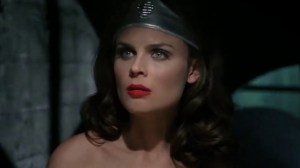The relationship between comic books and their covers has always been fascinating to me. The better part of the past century has proved that a striking cover image can push forward ideas that revolutionize the entire industry, plague an otherwise-fine book with controversy, or falsely advertise a plot point. Amid the more than half-dozen variant covers of this week’s Absolute Power #1, the beginning of DC’s latest line-wide event, one provides a striking encapsulation of the story within. It’s not the main cover, but Chrissie Zullo’s gloriously cartoonish “Sandbox” variant cover, which shows a child version of Amanda Waller excitedly (or maniacally, depending on your interpretation) playing with dolls of the Justice League’s heroes. After years of teasing Waller’s grand plan to take power in the DC universe, Absolute Power #1 puts it into action in a frustrating frenzy, one that is largely saved by the fact that the title has two of the industry’s best creators, Mark Waid and Dan Mora, at the helm.
Videos by ComicBook.com
Absolute Power #1 shows Waller, having acquired the talents of the maniacal Batman villain Failsafe and a newly-reborn Brainiac Queen, launching her no-holds-barred fight against the metahumans of the world. After destroying the credibility of the superhero community in the eyes of the public, Waller instigates an all-out war that will strip countless heroes of their powers and potentially reshape the DC universe as we know it. Together, heroes from across the world must form an alliance to stay alive, as even that challenge becomes increasingly impossible.
Waid is no stranger to using a DC universe-spanning threat to tap into larger cultural themes; his and Alex Ross’ work on 1996’s Kingdom Come is regarded to be one of the most poignant stories of that decade, if not all of modern DC, thanks in part to its dense portrait of heroism and legacy. He also is no stranger to compelling character dynamics, as exemplified everywhere from 1998’s JLA: Year One to his and Mora’s recent work on Batman / Superman: World’s Finest. All of this does make Absolute Power #1 into a much stronger reading experience than it easily could be, one that crackles with urgency and a sense of rapport from countless characters, even as they spout frantic lines of exposition. The issue is also surprisingly relevant to our current moment, offering commentary on artificial intelligence and misinformation that is only growing more necessary by the day. Even as the issue descends into its bleakest territory, it almost presents the larger event as a fascinating puzzle, as the reader is left to wonder exactly how the superhero community can get out of this situation.
The narrative problem with Absolute Power is, arguably, one that Waid inherited from the past few years of Waller stories in DC comics, which have foregone her complex views on chaos and order in favor of a simpler nihilism. Waller has, for lack of a better term, been “Flanderized” for the sake of the larger conflict, leading her to take action in dark ways that are increasingly improbable, and coupled with an unflinching stance on why she believes she is in the right. Even if some twist is on the horizon that walks back her staunch anti-superpower beliefs, the events of Absolute Power have already done heaps of damage to her presence in DC continuity going forward. Without getting into spoilers, that same dissonance can be felt with another hero who has allied themselves with Waller, despite decades of canon evidence to suggest they hold an opposite view, although fans have already speculated that they are operating as some sort of double agent. Again, this tightrope of storytelling and potential character assassination would be much more harrowing if anyone outside of Waid was at the helm, but there’s absolutely no telling at this point how these plot points will land.
Mora embraces the Herculean effort of rendering locales and characters scattered across the DC universe, effortlessly transporting the reader from one dire situation to the next. As has been the case with his work on World’s Finest, it is absolutely electrifying seeing Mora’s interpretations of different characters’ aesthetics and physiques, whether in the throes of battle or in a fleeting quiet moment. This works wonders as the actual events of Absolute Power #1 grow more upsetting, without ever becoming too dark or gruesome to look at. Alejandro Sanchez’s color work bathes the entire setting in hues that are dark, but still evoke a sense of vibrance. Ariana Maher’s lettering effortlessly carries the reader through the chaos, all while delivering thematic gut punches at just the right moments.
Absolute Power #1 might be the rare comic book where the execution vastly outweighs its central concept, as Waid, Mora, and company give it their all in rendering DC’s next monster event. That does not excuse the issue of its flaws, namely the grandfathered-in characterization of its central villainess, but it does prevent the event from veering towards total narrative desolation. Luckily, through various tie-ins and one-shots, we’ll get plenty of chances to see if and how Absolute Power ultimately proves itself, but at least the artistry on display makes the central title interesting.
Published by DC Comics
On July 3, 2024
Written by Mark Waid
Art by Dan Mora
Colors by Alejandro Sanchez
Letters by Ariana Maher
Cover by Dan Mora








